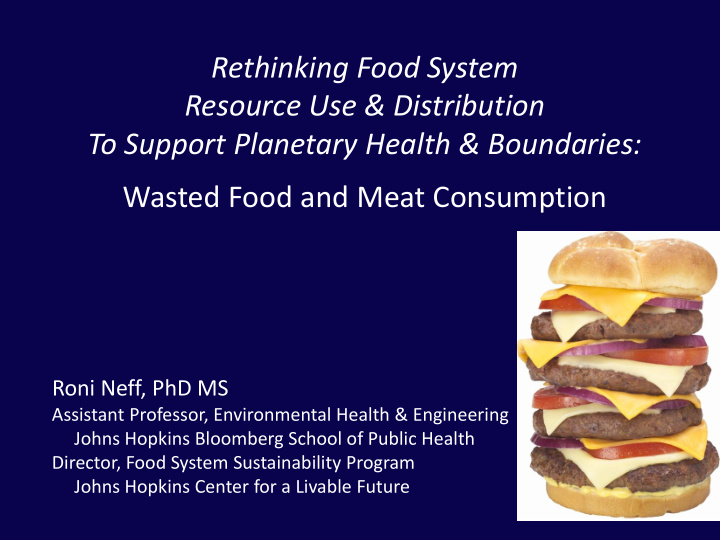



Rethinking Food System Resource Use & Distribution To Support Planetary Health & Boundaries: Wasted Food and Meat Consumption Roni Neff, PhD MS Assistant Professor, Environmental Health & Engineering Johns Hopkins Bloomberg School of Public Health Director, Food System Sustainability Program Johns Hopkins Center for a Livable Future
“We cannot get into the doughnut’s safe and just space without tackling the distribution of global resource use in both consumption and production. “ -Kate Raworth
WASTED FOOD & PLANETARY/HUMAN HEALTH
Wasted Food Greenhouse Gas Emissions China #1 Republic of wasted food #3 US #2 UN FAO 2013
In the U.S. • 40% U.S. food supply wasted (Hall, 2009) • 50% increase since 1970s – About 40% each consumers and consumer- facing businesses (ReFED 2016) Graphic: Just eat it film
Spiker, Hiza, Siddiqi, & Neff. 2017. Wasted Food, Wasted Nutrients: Nutrient Loss from Wasted Food in the United States & Comparison to Gaps in Dietary Intake. JAND.
Why do consumers discard food? Concerned about food safety and freshness. Neff, Spiker, Truant 2015
What Motivates Wasting Less? • Money is top motivator • $1,500 average family of 4 (Buzby, 2014) • Environmental concerns rank lowest Neff, Spiker, Truant. Wasted food: US consumer awareness, attitudes and behaviors, PLOS ONE 2015
Setting Targets • US: pledged 50% reduction by 2030 (USDA, EPA, 2015) • Systems approach - key relevant features – Across food chain, complexity, interactions among components/factors, attention to unintended consequences, feedback loops (not always co-benefits) • UK: Comprehensive interventions at consumer level, education, business changes, policy, all informed by research, evaluation 21% reduction in avoidable consumer waste of food, 5 years (WRAP 2013, 2014)
Public Health Co-Benefits of Addressing Wasted Food • Nutrition – Behaviors benefit both, e.g., avoid excess, planning – Packaging – size, frozen, etc. – BUT: processed • Food Safety – Learn better “home economics” skills – BUT: “Just eat it” • Food Security – Avoid food production impacts on resources, climate, etc. – Save $ - less waste, purchasing “seconds” – Recovered/donated food feeds people Neff, Kanter & Vandevijvere , Reducing Food Loss & Waste While Improving the Public’s Health. Health Affairs. 2015.
BUT: donation quality, dignity concerns
BUT: risk of “too much” appeal – lose big picture Food recovery is not the solution to hunger OR waste
MEAT AND PLANETARY/HUMAN HEALTH Image: wikimedia commons
Feed Conversion Ratios of Animal Source Foods Energy (fossil fuel use : lb protein) Water (L water : kg meat) Feed (kg feed : kg meat)
Cradle to Farmgate Impact (Kim, Santo, Scatterday, Neff, Nachman, in progress)
Meat & Public Health • U.S. meat consumption 20-60% above recommendations in 2015-20 DGA (Fehrenbach, Righter & Santo, 2015; DGA 2015) • Excess meat consumption, esp red/processed (Pan et al, 2012, Sinha et al, 2009, Micha et al 2010, Kaluza et al 2012, Pan et al 2011, Vergnaud et al, 2010, Wang et al, 2015, etc.) – Heart disease, stroke, T2 diabetes, obesity, some cancers – Red/processed assoc w higher overall, cardiovascular and cancer mortality
• 32% eat less meat now than 3 years ago • Of those not currently reducing meat, about 1/3 want to in future (NPR/Thomson Reuters 2015) Harley Schwadron
What explains change in amount of meat you eat? Cost 51% Health 50% Other 23% Environment 12% Welfare 12% Refuse 2% 0% 10% 20% 30% 40% 50% 60% Neff, Edwards, Righter, Palmer, Wolfson, in progress
Non-Reducers: Agreement with Statements Healthy diet includes meat Meals incomplete Boring Too expensive Not filling Don't like Not a big vegetable eater Don't know how - cook meatless 0% 5% 10% 15% 20% 25% 30% 35% Neff, Edwards, Righter, Palmer, Wolfson, in progress
Systems Approach to Changing Meat Consumption – Example • Level playing field for animal products vs produce – Regulations on meat production: clean air/water; antibiotics – Address disparate government support – Carbon tax policies that account for livestock emissions …? Chatham house, Neff
Roles for Nutrition Educators • Advice - Waste – Challenge “Fresh” and overly precautionary discarding – Encourage uses of leftovers, spare ingredients – Encourage waste tracking • Advice - Meat – Challenge ideas like: “A healthy diet includes meat” – Meats not all same; replacements matter too – Convenience, cost saving • Engage in policy efforts on wasted food, meat, food security/poverty, and environment
Conclusions • Diet pushing us to the edge of planetary and social boundaries – We must rethink food system resource use, distribution – Cut waste of food and meat consumption • Dietary choices guided less by environmental or social concern than nutrition and economics – Critical co-benefits exist • Nutritionists uniquely positioned to use systems thinking, build on co-benefits, help push us back into the safe & just space for humanity
Thank you! Roni Neff, PhD Rneff1@jhu.edu The Johns Hopkins Center for a Livable Future www.jhsph.edu/clf F ood systems & public health Research, policy, communications, education Opportunities for students include: • Doctoral fellowships • Food systems certificate • MPH concentration
Recommend
More recommend